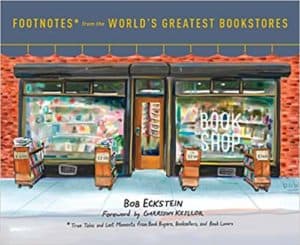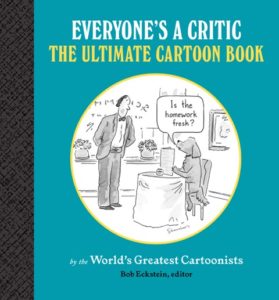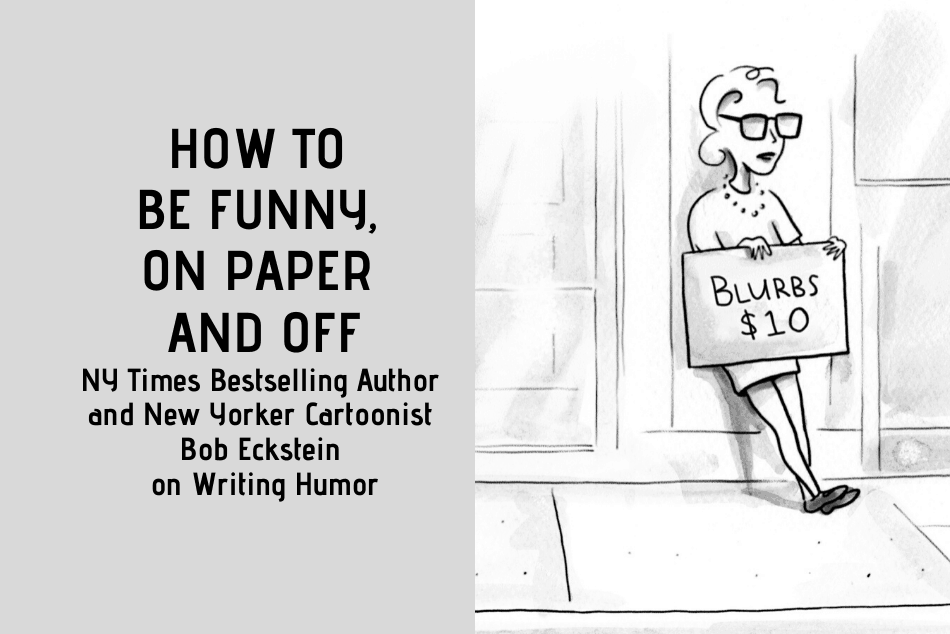When I met Bob Eckstein at the Writer’s Digest Conference last year, I never dreamed he would immortalize me in a New Yorker cartoon. But that’s what happened—and I’ve been an even bigger fan of his work ever since. On behalf of Career Authors, I sat down with Bob to talk about his wit, his work and his world view—not necessarily in that order.
CA: Did you always know you were funny?
Bob: I thought I could be, but I wasn’t sure until a college writing professor singled out my work and read it to the class at the end of each session, anonymously, and the class would laugh. This was a thing, because growing up my friends and family didn’t necessarily give me any indication that I was funny (unless I missed the signals). I wasn’t class clown, or even able to break into the high school newspaper. I tried. And I had enough of an ego to submit my work as a teenager to real publications even though my college paper also rejected everything I submitted. But I got published in SPY magazine (which was considered the premier humor venue) and got work at other publications when I was a teenager. But I was not a humorist, not in my own eyes, yet, anyway. And, certainly, I was uneducated regarding comedy. Clueless.
That changed very quickly in 2007. I submitted to The New Yorker on a dare from cartoon legend Sam Gross, who obviously saw something in me. They bought the first cartoon I submitted (which was the first gag cartoon I drew), and then I regretted waiting so long to convince myself I should make a living by being funny. Finally, I dove into comedy, absorbing everything I could on the subject.
My confidence would build as my exposure trickled and comedians, some very well-known, complimented me. I make it a point to compliment those around who deserve support and encouragement. I say that not because I feel I am well-known, but beause I recognize the power of a compliment.
CA: How did you become the acclaimed cartoonist and author you are today?
Bob: If I was interviewing myself, I would never word it that way. I can’t say I think of myself as accomplished as the question infers. I’m still surprised when people show up to my events. That said, I DO think the fact that I’ve made a living from this is a noteworthy feat. But to now answer your question: hard work, luck, and reckless abandon when pitching myself.

I keep laying down train tracks, just moving forward and staying in my own lane, not comparing myself to others or asking why them and not me. Good luck with that, because everyone is a little guilty of that, at least in the beginning. But you must try to not let yourself get those ugly traits of jealously and envy. It certainly will not make you a better artist or writer. And I’ll share a funny thing. As you get more successful, you constantly meet people who are even more successful. It’s like a cruel joke that you will inevitably meet someone bigger than you. You can’t win that game so just stay in your lane—do the best work you can do.
CA: Which comes first, the image or the text?
Bob: While it’s different circumstances each time, it’s often the text or idea that comes first.
CA: What’s your writing process?
Bob: Right now, I try to grab time when I can. That’s my process. I teach, speak, create cartoons, do live-draw events—and I’m in the middle of two screenplays and four books. That said, I rewrite pieces multiple times when I can. One of the books I’m in the middle of I’ve done ten drafts of.
CA: There are so many theories about humor: Tragedy plus time, the pairing of two disparate things, etc. What makes something funny?
Bob: If it makes someone laugh, then no theory is necessary. I know many people who are well-versed on humor theory who cannot make someone laugh out loud.
Gun to my head, I would say that cartoons fall into this category: A set-up that is familiar (why tropes are so popular) with an added element of tension, finished off with something.
CA: You’re also good at writing prose. I’m thinking of your wonderful books The Illustrated History of the SNOWMAN (which makes a great holiday gift, people, I’m just saying) and Footnotes from the World’s Greatest Bookstores. How did you come up with the ideas for these very different yet equally entertaining books?

Bob: Thanks. It’s from a lifetime of having people around me suggest those ideas or inspire those ideas. An editor may suggest something, and I add to it. I have an agent and a wife who let me make mistakes. When you are surrounded by people who support you even if you fail, you take risks—and risks create happy mistakes.
Ultimately, the ideas come from wishing I had that book in front of me to read—and then I decide maybe I could try writing it. I came up with the snowman book wandering around Barnes & Noble, wondering what was missing. (In that case, a nondenominational holiday book.)
CA: Your new book EVERYONE’S A CRITIC is all about reviews and reviewers (I’m giving copies to all my writer friends). As you point out, we live in a like/unlike, swipe left/swipe right world where everyone literally is a critic. What inspired you to write this?
Bob: First, let me say that’s an excellent idea (giving copies to all your writer friends!). I believe you answered the question yourself, calling nowadays a swipe left/swipe right world. The whole thing is quite amazing. Doesn’t it feel like we are all on the stage and there is no one left in the audience?
CA: Criticism of humor can be particularly vociferous. How do you handle it when the joke falls flat?
Bob: Honestly, I can get defensive. That’s my baby, and nobody likes being told they have an ugly baby. In rare moments when I am being an adult, I can learn from that and take it for what it is. Often it is a case of ineffective storytelling. I always tell myself the job description of an artist in any discipline is to correctly communicate. If a joke fails, that’s on me.
CA: Humor can be subjective. How do you decide what will be funny to the most people?
Bob: At the risk of sounding conceited, humor is only subjective to a point. There are clearly good and bad jokes. It’s clear to me immediately which cartoons are better than others, and after seeing thousands of cartoons I can pass judgment on a cartoon in five seconds. I used to criticize (former New Yorker Cartoon Editor) Bob Mankoff for rifling through cartoons but I understand that skill set now. I don’t pander or second-guess what others will find funny. I go by merit in the merit system I’ve developed from experience.

CA: Do you write to a given audience, like, say, The New Yorker readers or Reader’s Digest readers? Do you think about it?
Bob: Funny is funny. A very good cartoon should have total crossover. If a New Yorker cartoon is cryptic and not funny, it’s not enough to excuse it because it appears in the New Yorker. It’s simply ineffective storytelling again. Nobody had to say that they couldn’t understand a Charles Addams cartoon or a Sam Gross cartoon, but they knew it must be good because it got published. The same is true for a McSweeney’s piece.
CA: One of the highlights of my professional life was your doing a cartoon of me at the Writer’s Digest Conference for The New Yorker. I thought I’d died and gone to heaven. Do all of your subjects react this way? Have any been unhappy with your portrayals?
Bob: At that last writer’s conference, two big-name speakers were unhappy with the drawings I did of them. One sent me a drawing of herself that she liked, done by someone else that she wanted me to use instead. It looked nothing like her and was done in the style of a greeting card. I declined and apologized but I believe she defriended me online.
Almost everyone else is pretty excited to be in these pieces. I like to think I show how smart they are.
CA: No argument there. What are you working on now?
Bob: I’m juggling a few things, but my focus is getting the word out about the new cartoon collection, doing podcasts, and writing pieces about it in various magazines. I hope to be drawing the finishes of my illustrated novel soon because that will mean my agent found a home for it. It’s a historical fiction comedy based on the true events of the missing Sir John Franklin. It’s an 1850 diary, with the text handwritten, of course. But at the moment, I’m answering this last question of Career Authors’ interview, trying to think of a clever ending to wrap it up. Any ideas?

Bob Eckstein is an award-winning writer, New Yorker cartoonist, contributing editor of Writer’s Digest and author of The New York Times bestselling Footnotes from the World’s Greatest Bookstores. He has been speaking publicly against online shopping to raise awareness for independent bookstores and teaches writing at NYU. He is the world’s only snowman expert (author of The Illustrated History of the Snowman). His new book is Everyone’s A Critic: The Ultimate Cartoon Book by the World’s Greatest Cartoonists.





